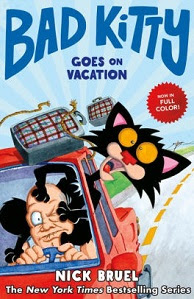An Invisible Goose Can Be Scary: Mindi and the Goose No One Could See by Sam McBratney
Mindi had a problem
Mindi was afraid of something no one else could see--a big goose in her room.
It came as quietly as a thought comes into your head, and it stayed as long as it wanted to.
"A WHAT?" asked her dad.Dad searched her whole room, including a thorough investigation under the bed. Mom laughed, but she brought a big wooden spoon to chase the goose out from behind the curtains. She locked the window so no goose could sneak in. But it didn't work. Mom and Dad found that they had a third person in their bed every night.
"Nobody has a goose in their bedroom," said Mom.
But Mindi insisted that SHE did.
Finally Dad decides that he must take Mindi to see the old wise man named Austen for advice about invisible goose problems. It was a long journey up the mountain to Austen's little farm--over the rocks in the stream amd wading through the creek, riding on Daddy's back on the steep uphill path and running down the hill ahead of Daddy, until finally they arrived at Austen's little farm. Mindi greeted all the animals, including the real geese. And as soon as they went into Austen's kitchen, a little goat pushed open the door and joined them. Austen let her feed the goat an apricot, and when Austen said he had too many animals to give this one a name, Mindi had an idea.
"I would call her Black and Whitey," said Mindi.
After a happy visit, Mindi and Daddy walked back down the mountain. On the way Dad asked Mindi carefully how she liked Austen's geese.
"THEY were nice geese. But the BIG goose isn't nice."she said.
It was beginning to look like the Big Goose was there to stay, when one stormy, rainy day, Austen appeared at their door--with Black and Whitey on a rope, a gift for Mindi. But then Austen explained that it's bad luck to give an animal away unless you receive another in return. Could Mindi part with her BIG Goose?
You BET she could, in the New York Times' best-selling author Sam McBratney's latest, Mindi and the Goose No One Else Could See (Candlewick Press, 2021). With the cozy rustic art of illustrator Linda Olafsdottir, this sweet story by McBratney, author of the best-selling series begun with Guess How Much I Love You, has in this picture book the same whimsical way of solving childhood needs and fears gently and patiently as in his earlier work. Although few parents would think of swapping an imaginary goose for a real goat to vanquish a nighttime fear, kids will love McBratney's fanciful solution. Says Kirkus Reviews, "Low-key and reassuring."
Labels: Anxiety in Children--Fiction Geese-Fiction (Grades Preschool-2)
































